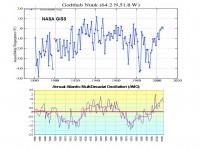By Joseph D’Aleo, CCM, AMS Fellow
The New York Times Magazine published a story “Ice Free” by Stephan Faris, hawking his new book “Forecast: The Consequences of Climate Change, From the Amazon to the Arctic, From Darfur to Napa Valley”, to be published in January.
In the article, Faris notes “Greenland’s ice sheet represents one of global warming’s most disturbing threats. The vast expanses of glaciers- massed, on average, 1.6 miles deep - contain enough water to raise sea levels worldwide by 23 feet. Should they melt or otherwise slip into the ocean, they would flood coastal capitals, submerge tropical islands and generally redraw the world’s atlases. The infusion of fresh water could slow or shut down the ocean’s currents, plunging Europe into bitter winter.”
There is little recognition in the media and by the author of history. Greenland actually was warmer in the 1930s and 1940s than it has been in recent decades. For the period from the 1960s to the 1990s, temperatures actually declined significantly as the Atlantic went through its multidecadal cold mode. The temperature changes up and down the last few centuries were closely related to these multidecadal ocean cycles.
Shown below is the temperature plot for Godthab Nuuk in southwest Greenland. Note how closely the temperatures track with the AMO (which is a measure of the Atlantic temperatures 0 to 70N). It shows that cooling from the 1940s to the late 1990s even as greenhouse gases rose steadily, a negative correlation over almost 5 decades. The rise after the middle 1990s was due to the flip of the AMO into its warm phase. They have not reached the level of the 1930s and 1940s.

See larger graphs here
Temperatures cooled back to the levels of the 1880s by the 1980s and 1990s. In a GRL paper in 2003, Hanna and Cappelen showed a significant cooling trend for eight stations in coastal southern Greenland from 1958 to 2001 (-1.29ºC for the 44 years). The temperature trend represented a strong negative correlation with increasing CO2 levels.
Many recent studies have addressed Greenland ice mass balance. They yield a broad picture of slight inland thickening and strong near-coastal thinning, primarily in the south along fast-moving outlet glaciers. However, interannual variability is very large, driven mainly by variability in summer melting and sudden glacier accelerations. Consequently, the short time interval covered by instrumental data is of concern in separating fluctuations from trends. But in a paper published in Science in February 2007, Dr. Ian Howat of the University of Washington reports that two of the largest glaciers have suddenly slowed, bringing the rate of melting last year down to near the previous rate. At one glacier, Kangerdlugssuaq, “average thinning over the glacier during the summer of 2006 declined to near zero, with some apparent thickening in areas on the main trunk.”
Dr. Howat in a follow-up interview with the New York Times went on to add: “Greenland was about as warm or warmer in the 1930’s and 40’s, and many of the glaciers were smaller than they are now. This was a period of rapid glacier shrinkage world-wide, followed by at least partial re-expansion during a colder period from the 1950’s to the 1980’s. Of course, we don’t know very much about how the glacier dynamics changed then because we didn’t have satellites to observe it. However, it does suggest that large variations in ice sheet dynamics can occur from natural climate variability.” For more on this issue see this full post here. SPPI has also posted a response here. EPW compiled a series of papers here.




